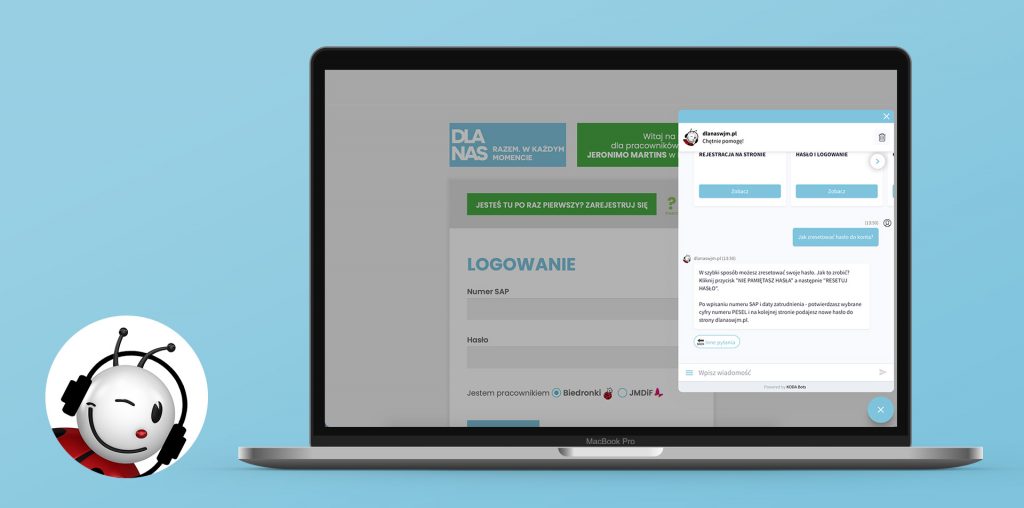Biedronka focuses on chatbots. Automation of internal communication processes – Jeronimo Martins

Carried out nearly
111 000
conversations
Met over
32 000
employees
Recognized and responded to
72%
of user messages sent
Challenges
- Reducing the number of calls to the social hotline on recurring topics
- Improved efficiency and speed of handling enquiries
Jeronimo Martins Polska, the owner of the Biedronka chain, makes it the largest private employer in Poland, with approx. 70,000 employees. Having them in mind, more than a dozen support programs are in place, with details available on the employee portal dlanaswjm.pl, accessible from anywhere and on any device. Employee enquiries, which are a natural given the scale of the operation, are primarily directed to dedicated internal helplines and email inboxes. They are handled on a daily basis by employees from various departments within the HR function. The average number of calls received annually by a hotline employee for social matters is over 10,000. A considerable portion of these are recurring queries, which refer to important issues, such as the platform registration, a particular social program or a social commission decision.
With increasing relevance (the portal is indicated as the main source of information in surveys) and popularity (in 2020 we recorded more than 20 million page views on dlanaswjm.pl), the number of hotline calls has also grown. We have aimed to increase the number of employees we can help. Biedronka looked to achieve this by handling the most frequently asked questions and repetitive processes automatically, thus providing assistance to a greater number of employees at the same time and taking the heat of the hotline staff, who could use their expertise to deal with more complex enquiries.
The supermarket chains is one of the first companies in Poland to decide to implement such a solution.

Solution
Communication has been automated with a chatbot that can be used on the all-employee portal dlanaswjm.pl
Testing
At this stage, a test implementation was carried out on the dlanaswjm.pl website: we launched a chatbot visible before logging in, with a focus on supporting users in registering on the website, resetting their passwords and providing them with general information about the website.
Working with the client, the KODA team analyzed the issues most frequently raised in these areas and the inquiries structure. During workshops, the relevant subject areas were identified and conversation scenarios were created. Once the simplified chatbot was implemented and rolled out to users, the KODA team tracked the conversations, updated the content accordingly and provided NLP training to ensure the chatbot continued to understand more and more.
Preparation and target implementation
The next stage saw the launch of a chatbot available on the dlanaswjm.pl website for logged-in users. At that point of implementation, we added to the chatbot answers to questions on a number of employee matters: support programs, income certificates or prepaid cards. Again, the involvement of the IT department and the integration with the API came into play at this stage. This way, each employee could also get personalized information about them in the chatbot, such as date of employment, decisions on submitted applications or the status of a submitted income statement application.
Once the materials were analyzed and prepared, they were entered into the chatbot database. The NLP engine was then set up so that the chatbot could recognize the questions asked of it.
Post-implementation work
Following the final implementation, just as in the first stage, we devoted a great deal of time to analyzing users’ conversations and the questions they asked. Based on the analysis and the data acquired, the chatbot’s knowledge base is continuously improved and the NLP engine optimized, with the aim to continually improve the chatbot’s effectiveness.
Subsequent stages of chatbot development
With further integration with the client’s API, other large-scale implementations were created, giving employees more options, including sending requests to generate a code for a prepaid card, submitting requests for other types of certificates, or holding quizzes and contests among employees.
At the same time, the content was continuously updated along with NLP training, and the chatbot’s adaptation to users’ needs increased over time.
Throughout all further stages of the chatbot’s development, the continuous and strong involvement of the Biedronka chain played a very important role. The client co-developed the solution with the KODA team from the very beginning, getting engaged during the development works and updating the content and NLP.
It is our main job to ensure that the solution is as useful as possible and meets the objectives set by the client. We want to work together in a spirit of partnership. With the experience gained in recent years and dozens of implementations in a wide variety of fields, we understand how automated communication can positively impact an organization. Yet, we are not afraid to experiment – we approach every project individually and look for new solutions tailored to the industry, purpose and strategic needs. We often say that the chatbot launch is also really the start of the whole adventure. We stay in touch with our customers and always make sure they feel our support all the time, not just in the first days. Since this is a new industry, with new competences, we are even more keen to ensure that our clients have the best possible first experiences. We work together at almost every possible stage – from inspiration, through planning the next steps to develop the tool, finding the right solutions to help achieve the goals, to regular interaction and trust building. While I am the one that clients work with directly, there is an entire team involved in making them feel secure: from the developers who make sure the platform is robust, to the project managers who manage tasks, to the chatbot trainers who spend every waking moment making the chatbots better and better. I am proud of the relationships we have forged and that our clients make the best ambassadors for KODA.
How to develop a bot?
The bot is developed with the organization. Ideas to add new threads and topics come not only from the HR department, but also from the employees, who start typing new queries in bot conversations. This results in lists of topics that have not yet been addressed, but need to be implemented in the system. It usually takes a few days from an idea for a new conversation topic to it being added. At times, introducing a new process requires the other company departments’ involvement and a broader collaboration in creating a conversation path for handling a new matter.
Thus, the chatbot is employed for various tasks. The latest addition is sending requests for certificates. The requests are sent directly to Excel and saved in a folder available to the HR and payroll department. Another feature of great interest is the possibility to check the decision concerning participation in social programs, as well as the option to check the assigned prepaid card, to which employees receive regular top-ups.
Regular work in the chatbot dashboard, i.e. generating reports, analyzing intent and conducted conversations, as well as working on the further development of the system yields results with a growing number of users. At the end of the day, it is rewarding to see how useful our employees find this tool. Statistics prove this, growing month by month in the number of calls made, new users, as well as an increasing percentage of detected intentions. It is also demonstrated by the satisfaction of Biedronka’s employees, who receive information on matters important to them promptly and efficiently.
Implementation results
The primary aim of the automation was to streamline the process of handling queries to the HR department. The automation has led to quantitative and qualitative changes. The number of queries raised through traditional communication channels has been reduced. These amount to thousands of questions per year, which are now answered by a virtual HR assistant.
Biedronka’s chatbot in two years of operation:
- carried out nearly 111,0000 conversations with 1.42 million messages sent to it
- met over 32,000 employees
- recognized and responded to 72% of user messages sent
- submitted over 4,200 requests for certificates
- checked more than 20,000 data from company systems
In 2021, the project won the “Power of Attraction” competition award held by the Puls Biznesu editorial office. It received the grand prize in the category “Modern technologies in HR.”
Chatbot has allowed us to provide support to a greater number of employees who – for various reasons – would not have been able to get help through the social hotline, for example. More than 32,000 employees made use of it in the first year of operation, and we see this indicator as a measure of the success of this implementation. In the process, we also achieve other objectives. Chatbot is fast (it replies immediately at any time), standard-oriented (answers on general issues are always the same), it provides content personalization, optimizes work (frees up time previously spent on handling recurring queries) and, finally, it is an agile tool, which proved to be extremely worthwhile – as soon as it was implemented, it had to operate in difficult times of the pandemic. Working with a chatbot is also highly development-oriented for the team. It brings HR and developers together, as they always talk about new solutions within the context of the instant messaging, and the dashboard shows everything that enables low-code work.
Nearly half (49%) of HR professionals have seen automation reduce administrative tasks, according to a 2019 survey by employment agency Hays.
Still, 34% of HR departments reported that their organization was slow to adapt to new technologies. HR departments have automated or are about to automate education systems (45%), payroll (42%) and recruitment administrative tasks such as onboarding processes and timesheets (39%).
Examples of HR processes which can be automated with a chatbot:
- Issuing employee certificates
- Checking account balance on a prepaid card
- Conducting employee surveys
- Informing on a decision regarding employee application
- Personalized offers of employee discounts
- Employee onboarding
Contact with us
You are one step away from separating yourself from the communication community in your organization
You can contact us and we will prepare a dedicated offer for you.